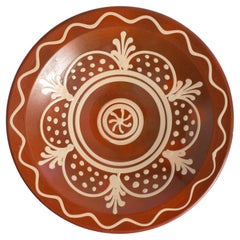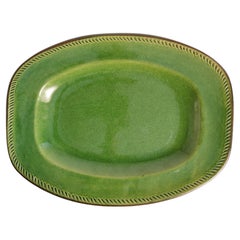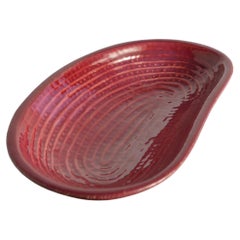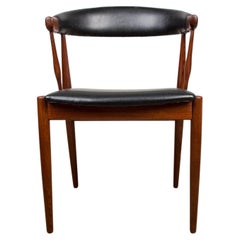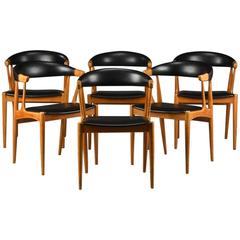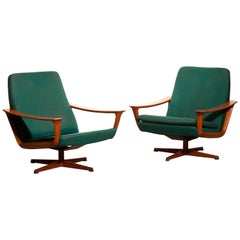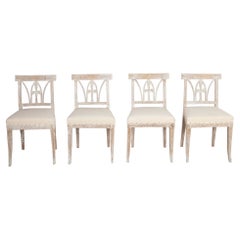Johannes Andersson
Vintage 1920s Swedish Folk Art Decorative Dishes and Vide-Poche
Stoneware
Vintage 1940s Swedish Mid-Century Modern Decorative Dishes and Vide-Poche
Stoneware
Early 20th Century Swedish Mid-Century Modern Decorative Bowls
Stoneware
Vintage 1950s Danish Armchairs
Leather, Teak
Vintage 1960s Danish Scandinavian Modern Dining Room Chairs
Faux Leather, Teak
Vintage 1960s Danish Scandinavian Modern Dining Room Chairs
Teak, Faux Leather
Vintage 1960s Danish Mid-Century Modern Lounge Chairs
Metal
Antique 18th Century Swedish Gustavian Dining Room Chairs
Linen, Wood, Paint
Johannes Andersson For Sale on 1stDibs
How Much is a Johannes Andersson?
Höganäs Keramik for sale on 1stDibs
Höganäs Keramik was the premier manufacturer of Swedish heat-resistant and heat-retentive stoneware in the early 20th century. Ceramics have had a home in Höganäs — which is in Scania County, Sweden — for hundreds of years, with the likes of Höganäsbolaget firing ware in its kilns since at least the early 1800s.
Johansson Olofsson and Sigfrid Johansson initially founded what would become Höganäs Keramik in 1909. Olofsson left in 1910 and Karl Andersson stepped in. The firm was called Andersson & Johansson for a period, and with durability and functionality driving the early designs over form, its inaugural pieces appeared modest and rustic. The founders later traded under Höganäs Keramik, and the company’s designs increasingly incorporated more vivid glazes and livelier forms, while also maintaining the durability and quality standards that had been synonymous with their output. By 1914, Höganäs Keramik pieces were interesting enough to participate in the Baltic Exhibition in Malmö, Sweden.
In the 1920s, Höganäs expanded their site in order to broaden their range of offerings and increase their production capabilities. Manufacturing at the firm grew during the 1940s, as they moved to a facility twice the size of their previous factory. In 1948, the company diversified its production to include molds, pots and pans.
In the 1950s, the company launched the Old Höganäs series, reflecting on the creations that brought their success, while also bringing in notable ceramicists such as John Andersson, Signe Persson-Melin and Hertha Bengtsson to contribute to their growing repertoire of designs.
Höganäs is now part of the Iittala Group, which was purchased by Fiskars Corporation in 2007, and remains celebrated for centuries of innovations in ceramic production.
On 1stDibs, find a selection of antique and vintage Höganäs Keramik serveware, lighting and ceramic decor.
A Close Look at Scandinavian-modern Furniture
Scandinavian modernism is perhaps the warmest and most organic iteration of modernist design. The work of the designers associated with vintage Scandinavian modern furniture was founded on centuries-old beliefs in both quality craftsmanship and the ideal that beauty should enhance even the humblest accessories of daily life.
ORIGINS OF SCANDINAVIAN MODERN FURNITURE DESIGN
- Emerged in the 1930s
- Scandinavian design and Nordic design originated primarily in Denmark, Sweden, Finland, Iceland and Norway
- Introduced in the United States in mid-20th century
- Informed by the Bauhaus; influenced American mid-century modernism
CHARACTERISTICS OF SCANDINAVIAN MODERN FURNITURE DESIGN
- Bold, clean lines and simple, sturdy symmetries
- Use of natural materials — native woods such as pine, ash and beech
- Open, airy spaces
- Promotion of functionality
- Emphasis on craftsmanship; rooted in cabinetry profession and traditional construction techniques
- Minimal ornamentation (little to no embellishment)
- A neutral or light color palette owing to prominence of light woods
SCANDINAVIAN MODERN FURNITURE DESIGNERS TO KNOW
- Alvar Aalto
- Hans Wegner
- Kaare Klint
- Arne Jacobsen
- Greta Magnusson Grossman
- Finn Juhl
- Arne Vodder
- Verner Panton
ICONIC SCANDINAVIAN MODERN FURNITURE DESIGNS
VINTAGE SCANDINAVIAN MODERN FURNITURE ON 1STDIBS
The gentle, organic contours that are typical of Scandinavian design appear in the furnishings and decor created by Danish, Finnish and Swedish designers not as a stylistic gesture, but rather as a practical, ergonomic — and, as importantly, elegant — response to the human form.
Each nation produced exceptional talents in all areas of the applied arts, yet each had its forté. Sweden was home to Greta Magnusson Grossman and Bruno Mathsson — creators of the classic Grasshopper lighting series and Berlin daybed, respectively — but the country excelled most notably at ceramics. In the 1920s at the great Gustavsberg porcelain manufactory, Wilhelm Kåge introduced pieces in the Scandinavian style based on influences from folklore to Cubism; his skills were passed on to his versatile and inspired pupils Berndt Friberg and Stig Lindberg.
Likewise, Finland produced a truly ingenious Scandinavian modern furniture designer in the architect Alvar Aalto, a master at melding function and artistic form in works like the Paimio chair, created in collaboration with his first wife, Aino. Yet Finnish glassware was pre-eminent, crafted in expressive, sculptural designs by Tapio Wirkkala and Timo Sarpaneva.
The Danes excelled at chairs. Hans Wegner and Arne Jacobsen were exemplars of the country’s facility with wood, particularly teak.
Wegner created such iconic pieces as the Round chair and the Wishbone chair; Jacobsen — while the revolutionary architect and furniture innovator produced the best-selling plywood Ant chair — designed two classic upholstered pieces of the 1950s: the Swan chair and Egg chair. The list of great Danes could go on and on, including Finn Juhl, a stylistic maverick and maker of the bold Chieftain chair; Poul Kjaerholm, with his lean metal-and-rattan aesthetic; and Verner Panton, who introduced a vibrant Pop note into international design.
Today, decades after their heyday, the prolific, ever-evolving Scandinavian modernists continue to amaze and delight, and interior designers all over the world use their pieces to bring warmth to any given space.
On 1stDibs, you will note both instantly recognizable vintage Scandinavian modern chairs, sofas, rugs and tables — those that have earned iconic status over time — and many new discoveries.
Finding the Right Decorative-objects for You
Every time you move into a house or an apartment — or endeavor to refresh the home you’ve lived in for years — life for that space begins anew. The right home accent, be it the simple placement of a decorative bowl on a shelf or a ceramic vase for fresh flowers, can transform an area from drab to spectacular. But with so many materials and items to choose from, it’s easy to get lost in the process. The key to styling with antique and vintage decorative objects is to work toward making a happy home that best reflects your personal style.
Ceramics are a versatile addition to any home. If you’ve amassed an assortment of functional pottery over the years, think of your mugs and salad bowls as decorative objects, ideal for displaying in a glass cabinet. Vintage ceramic serveware can pop along white open shelving in your dining area, while large stoneware pitchers paired with woven baskets or quilts in an open cupboard can introduce a rustic farmhouse-style element to your den.
Translucent decorative boxes or bowls made of an acrylic plastic called Lucite — a game changer in furniture that’s easy to clean and lasts long — are modern accents that are neutral enough to dress up a coffee table or desktop without cluttering it. If you’re showcasing pieces from the past, a vintage jewelry box for displaying your treasures can spark conversation: Where is the jewelry box from? Is there a story behind it?
Abstract sculptures or an antique vessel for your home library can draw attention to your book collection and add narrative charm to the most appropriate of corners. There’s more than one way to style your bookcases, and decorative objects add a provocative dynamic. “I love magnifying glasses,” says Alex Assouline, global vice president of luxury publisher Assouline, of adding one’s cherished objects to a home library. “They are both useful and decorative. Objects really elevate libraries and can also make them more personal.”
To help with personalizing your space and truly making it your own, find an extraordinary collection of decorative objects on 1stDibs.
